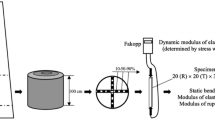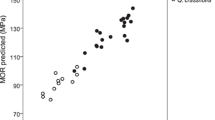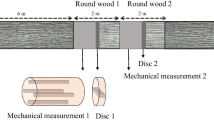Abstract
Small clear specimens of 30×30×450 mm were prepared from plantation-grown Eucalyptus globulus, E. nitens and E. regnans that were between 15 and 31 years of age. Their modulus of elasticity (MOE) and modulus of rupture (MOR) were determined using static central-point-loading bending tests. Their microfibril angle (MFA) and density were determined using SilviScan on strip samples removed from the intact portion of the specimens after the bending tests. It was found that MFA alone accounted for 87 percent of the variation in MOE, while density alone accounted for 81 percent. Together, MFA and density (as Density/MFA) accounted for 92 percent of the variation in MOE. The MFA “impact diminishing” pointFootnote 1 appears to be 16 degrees for the wood material of three eucalypt species in this study. Density alone accounted for 80 percent of the variation in MOR, whereas MFA had little independent influence on MOR.
Zusammenfassung
Kleine fehlerfreie Proben (30×30×450 mm) wurden aus 15 bis 33 Jahre alten Eucalyptus globulus, E. nitens und E. regnans aus Plantagenanbau geschnitten. Deren MOE und MOR wurden unter statischer zentraler Belastung im Biegetest bestimmt. Außerdem wurden der Mikrofibrillenwinkel (MFA) und die Dichte bestimmt, und zwar mittels SilviScan an Probestreifen, die nach dem Biegetest aus intakten Probeteilen geschnitten wurden. Es zeigte sich, daß allein der Mikrofibrillenwinkel zu 87 Prozent für die Variation des MOE verantwortlich ist, die Dichte für sich allein nur für 81 Prozent. MFA und Dichte zusammen (als Quotient Dichte/MFA) erklären 92 Prozent der Variation des MOE. Die Grenze des negativen Einflusses des Mikrofibrillenwinkels scheint für das vorliegende Probenmaterial bei 16 Grad zu liegen. Im Falle des MOR ist die Dichte allein für 80 Prozent der Variation verantwortlich, wogegen der MFA nur einen geringen unabhängigen Einfluß auf den MOR hat.
Similar content being viewed by others
Avoid common mistakes on your manuscript.
1 Introduction
Modulus of elasticity (MOE) is one of the most important mechanical properties for solid timber applications. It has received considerable attention in recent years due to the fact that fast-grown plantation timber that contains large proportions of juvenile wood is coming into the supply chain and juvenile wood has poorer properties including MOE. MOE is largely influenced by both density (Kollmann and Côté 1984; Panshin and de Zeeuw 1980) and microbril angle (Cave and Walker 1994; Dickson and Walker 1997; Evans and Ilic 2001; Evans et al. 2000; Hirakawa et al. 1997; Tsehaye et al. 1995; Walker and Butterfield 1995). Rapid and non-destructive evaluation of MOE has great importance to tree breeders as well as to several other considerations in optimal timber utilization. Recent studies showed that MFA and density jointly accounted for 96% of the variation in longitudinal MOE of Eucalyptus delegatensis that was non-destructively determined from the natural frequency of resonant vibrations (Evans and Ilic 2001). Rapid and non-destructive evaluation of MOE hence has become a reality because measurement of MFA and density nowadays is a fast routine operation at CSIRO through the use of SilviScan.
During early 1990s, two studies were carried out to evaluate the potential of producing structural sawn timber from plantation-grown E. globulus, E. nitens and E. regnans (Yang and Waugh 1996a, b). The trees used were between 15 and 33 years of age at the time of harvest. Specific aspects of interest were mechanical properties, and the effect of tree growth attributes (knots, kino occurrence, drying defects). The mechanical properties were assessed using two methods: (1) strength grouping and visual stress grading, to estimate stress grades, (2) in-grade testing to quantitatively determine stress grade of the population, to check the results obtained by the first method. Static MOE and MOR were tested on small clear specimens as required by the in-grade testing. Several years later, MFA became easily measurable using SilviScan at CSIRO. We then took the opportunity to measure MFA and examine its relationship with MOE in these eucalypt species. The results are reported in this paper.
2 Experimental Method
2.1 Specimens for test
In two earlier studies (Yang and Waugh 1996a, b), sawn boards of 4 m long were cut from several heights of 36 plantation-grown E. globulus, E. nitens and E. regnans trees between 15 and 33 years of age. From the 177 boards that came from pre-specified inner and outer heartwood locations of each log, small clear specimens of 30×30×450 mm were prepared (one specimen per board).
2.2 Testing, measurements and analysis
The specimens were tested under central point loading with a test span of 420 mm using the Southwark-Emery testing machine. Although the specimens were not of the standard size recommended by Mack (1979), their geometry and the test span were proportional to those as required in Mack (1979). The load at rupture was recorded, and the load and deflection at the proportional limit determined from the recording chart. MOR and MOE were calculated using the formulae detailed in Mack (1979).
MFA and density of 130 of these small clear specimens was measured after the bending tests. One 2×30×6 mm strip (tangential × radial × longitudinal) was removed from an intact portion of each bending specimen and scanned using SilviScan. Average MFA and density of each strip was used to represent those of the corresponding bending specimen. An outline of these 130 specimens is given in Table 1. Details of the sites and tree characteristics are provided in Yang and Waugh (1996a, b).
Relationships between MOE, MOR, MFA, density and Density/MFA were examined. A power-curve fit was used when MFA was included in a relationship.
3 Results and discussion
3.1 Mean values
E. globulus has much higher MOE, MOR and density, but much lower MFA, than E. nitens and E. regnans (Table 2). E. nitens and E. regnans have similar MOR and density, but MOE of E. nitens is lower and it appears to be related to its higher MFA (Table 2). E. globulus has much greater variation in density and MOR than the other two species.
3.2 Relationships between properties
Coefficients of determination (R2) for relationships between MOE, MOR, MFA, density, and Density/MFA are summarized in Table 3. Relationships that include MFA were power-curve fit (y=a+bxc). The other relationships were straight-line fit (y=a+bx). All relationships were significant at 1% level.
Relationship of MFA with density varies between species (Fig. 1). MFA and density of E. regnans was negatively and weakly correlated and the relationship remained as a straight line over the entire range of MFA. For E. nitens, the relationship was a power-curve fit with a slight negative slope. For E. globulus, the relationship was an approximately straight line with negative steep slope.
MOE and MOR were highly correlated (R2=0.79). The relationship was closer than those found in studies on Tasmanian regrowth eucalypt wood (R2=0.66, Yang et al. 2000).
Both MOE and MOR were highly correlated with MFA. MFA alone accounted for about 87% of the variation in MOE and 82% in MOR (Table 3). MOE and MOR were also highly correlated with density, at an approximately similar level. Density alone accounted for about 80% of the variation in MOE and MOR (Table 3).
MFA is known to have a large impact on MOE through an inverse relationship (Cave and Walker 1994; Evans and Ilic 2001; Evans et al. 2000; Hirakawa et al. 1997). However, MOE did not seem to reduce further beyond a certain point of MFA, as shown in Fig. 2. Such “impact diminishing” point was about 16 degrees for the wood material of three eucalypt species in this study. Also, data points between 9 to 12 degrees of MFA in Fig. 2 clearly show that MFA is not the only factor that influences MOE. Density was highly correlated with MOE (R2=0.80, Table 3) and its joint effect on MOE is discussed below.
To examine the combined effect of MFA and density on MOE and MOR, a parameter Density/MFA was used as previously reported by Evans and Ilic (2001). We found in this study that this parameter was an excellent predictor of MOEFootnote 2 (R2=0.92, Table 3) and the relationship is a simple straight line (Fig. 3). This result is in accordance with that by Evans and Ilic (2001) who found R2=0.96 between MOE and Density/MFA for regrowth E. delegatensis. The lower coefficient of determination in this study (0.92) may be attributed to the fact that there were three species in the analysis and the data of E. globulus were more scattered around the regression line than the other two species (Fig. 3). MFA appeared to have little independent influence on MOR. This is because the relationship of MOR with Density/MFA (R2=0.75) was not as close as with density (R2=0.80). Also, in a multiple regression analysis of MOR, the contribution of MFA became insignificant in the presence of density.
4 Conclusions
MFA and density both had significant and independent effects on MOE. MFA alone accounted for 87 percent of the variation in MOE but an increase in MFA beyond 16 degrees did not appear to result in further significant decrease in MOE for the wood material of three eucalypt species in this study. Density alone accounted for 81 percent of the variation in MOE. Jointly, MFA and density (as Density/MFA) accounted for 92 percent. This result is another strong indication that MOE can be reliably predicted or estimated from measurements of MFA and density on increment cores. The best single predictor of MOR was density. MFA did not have an independent effect on MOR.
Notes
A MFA value beyond which an increase in MFA results in little further decrease in MOE.
Other forms of equations, e.g. polynomial and log relationships, could also well predict measured MOE as found in this study.
References
Cave ID, Walker JCF (1994) Stiffness of wood in fast-grown plantation softwoods: The influence of microfibril angle. For Prod J 44(5):43–48
Dickson RL, Walker JCF (1997) Selecting wood quality characteristics for pines. In: Proceedings of CTIA/IUFRO International Wood Quality Workshop “Timber Management Toward Wood Quality and End-Product Value”, Quebec City, Canada, 18–22 August 1997
Evans R, Ilic J (2001) Rapid prediction of wood stiffness from microfibril angle and density. For Prod J 51(3):53–57
Evans R, Ilic J, Matheson AC (2000) Rapid estimation of solid wood stiffness using SilivScan. In: Proceedings of 26th For. Prod. Res. Conf., CSIRO Forestry and Forest Products, Clayton, Australia, pp 49–50
Hirakawa Y, Yamashita K, Fujisawa Y, Nakada R, Kijidani Y (1997) The effects of S2 microfibril angles and density on MOE in sugi tree logs. Proceedings (ed. Butterfield, B.G.) IAWA/IUFRO International Workshop on the Significance of Microfibril Angle to Wood Quality, Westport, New Zealand, November 1997, pp 312–322
Kollmann FFP, Côté WA Jr. (1984) Principles of wood science and technology. I. Solid wood. Springer, Berlin Heidelberg New York p 292
Mack JJ (1979) Australian methods for mechanically testing small clear specimens of timber. CSIRO Div. Build. Res. Technical Paper (2nd series) No. 31, 19 pp
Panshin AJ, de Zeeuw C (1980) Textbook of wood technology. McGraw-Hill Book Company, New York, 722 pp
Tsehaye A, Buchanan AH, Walker JCF (1995) A comparison of density and stiffness for predicting wood quality or density: the lazy man’s guide to wood quality. J Instit Wood Sci 13(6):539–543
Walker JCH, Butterfield BG (1995) The importance of microfibril angle for the processing industries. New Zealand Forestry, November 1995
Yang JL, Wardlaw T, Scott L (2000) Density and strength characteristics of discolored and decayed regrowth eucalypts—a preliminary study. Australian Forestry 63(3):188–193
Yang JL, Waugh G (1996a) Potential of plantation-grown eucalypts for structural sawn products. I. Eucalyptus globulus Labill. spp. globulus. Australian Forestry 59:90–98
Yang JL, Waugh G (1996b) Potential of plantation-grown eucalypts for structural sawn products. II. Eucalyptus nitens (Deane & Maiden) Maiden and E. regnans F. Muell. Australian Forestry 59:99–107
Acknowledgement
We thank Mrs S Molenaar for the static bending tests, Mr. J Ilic and Mr. G Freischmidt of CSIRO for their valuable comments on this manuscript prior to submission to the journal.
Author information
Authors and Affiliations
Corresponding author
Rights and permissions
About this article
Cite this article
Yang, J.L., Evans, R. Prediction of MOE of eucalypt wood from microfibril angle and density. Holz Roh Werkst 61, 449–452 (2003). https://doi.org/10.1007/s00107-003-0424-3
Published:
Issue Date:
DOI: https://doi.org/10.1007/s00107-003-0424-3







